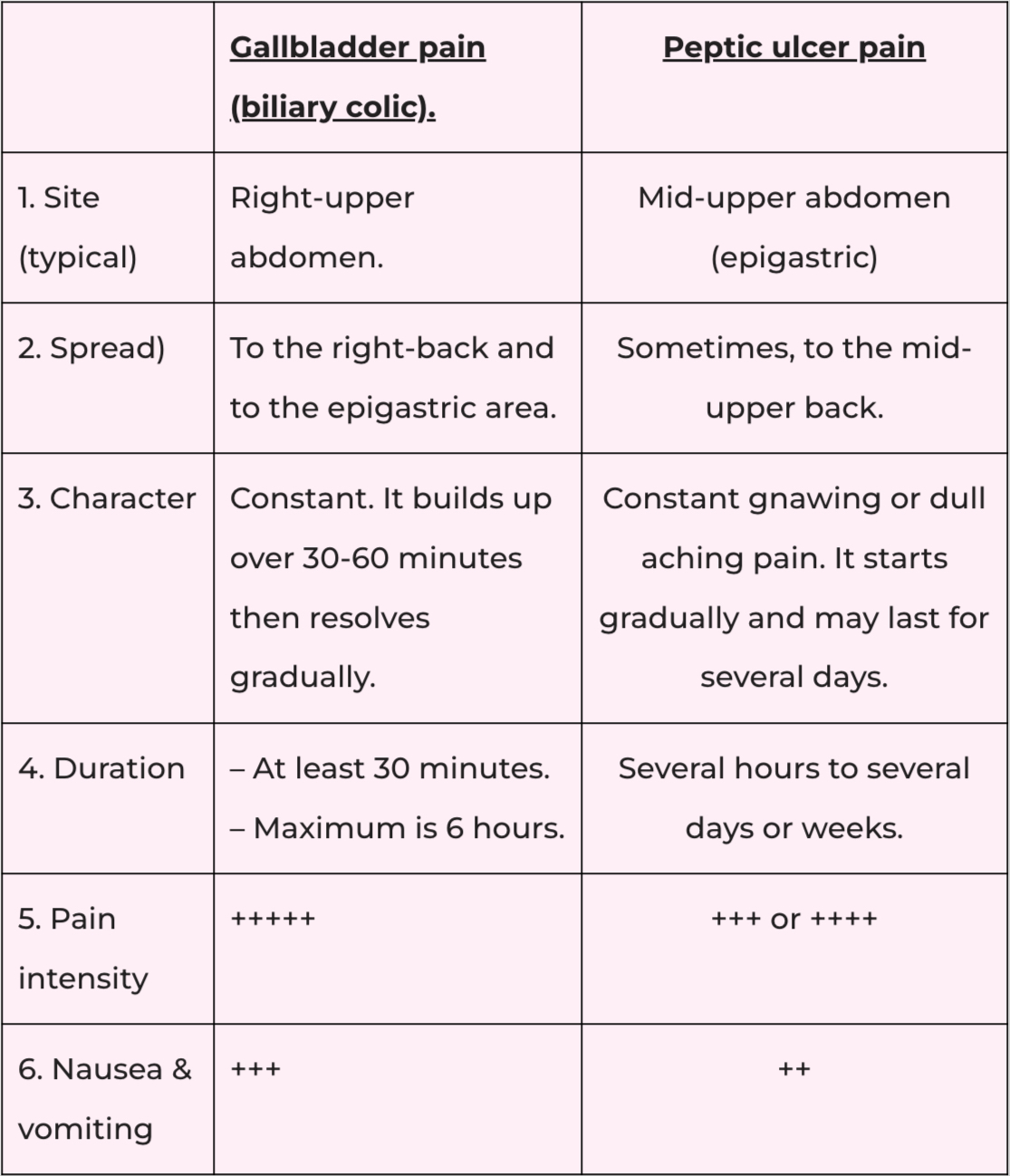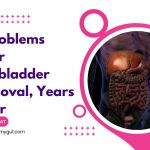5 Gallbladder Symptoms in Women.
Our content is not intended nor recommended as a substitute for medical advice by your doctor. Use for informational purposes only.
The most common gallbladder symptoms in women are right upper quadrant pain that may refer to the back, severe nausea, vomiting, and bloating.
Here is a list of the most common gallbladder symptoms in women:
- Right upper abdominal pain.
- Right shoulder or right back pain.
- Severe nausea after eating.
- Attacks of anorexia.
- Bloating and fullness after eating.
- Vomiting.
- Complicated gallstone disease may present with severe tenderness.
1. Right upper abdominal pain (that comes in attacks).
The gallbladder is attached to your liver and is located in the right upper abdomen.
A woman with a gallbladder problem (such as gallstones) typically experiences upper right abdominal pain.
The most common cause of gallbladder problems in women is gallstones.
Gallstones inside your gallbladder or biliary canal are divided into two categories:
- Uncomplicated gallbladder stones: often asymptomatic or present with occasional attacks of typical biliary colics (described in the table below).
- Complicated gallstone disease: acute cholecystitis (inflamed gallbladder with severe pain and fever) or obstruction of the bile ducts (manifested with jaundice).
Uncomplicated gallstones cause typical biliary colics (pain in the right upper abdomen), the first sign of a bad gallbladder.
The characteristics of a typical attack of gallbladder pain or biliary colic are in the table below (reference).
| Biliary colic (Uncomplicated gallstone). | Description |
|---|---|
| 1. Site | Usually, The right upper quadrant of your abdomen |
| 2. Spread | – The pain may spread to the back of the right shoulder.– Also, it spreads to the epigastric area. |
| 3. Character | Constant builds up then disappears gradually. |
| 4. Duration | At least 30 minutes. It may last up to 6 hours. |
| 5. Relation to food | – Triggered by foods (especially fatty food and large meals.– However, it can start spontaneously. |
| 6. NOT related to:Movement, bowel movements, or the passage of flatus. | |
| 7. Nausea | Often Present, severe. |
| 8- Commonly associated symptoms | Vomiting and sweating during the attack. |
| 6. Unusual symptoms. | – Heartburn and chest pain.– Bloating, fullness.– Early satiety.– Isolated epigastric pain. |
| 6. Symptoms NOT associated:(Complicated gallbladder disease). | – Fever.– Jaundice.– Prolonged pain for more than 6 hours.– Extreme tenderness over the gallbladder (Murphy’s sign).– Vomiting of blood, blackish stool (PUD). |
More:
2. Right shoulder and right back pain.
The pain from the gallbladder often refers to the right shoulder blade. When you have pain in your right upper abdomen and right shoulder blade, you likely have a gallbladder problem.
The right shoulder pain due to gallbladder problems differs from the local causes of shoulder pain. Right shoulder pain due to gallbladder problems is often:
- Not associated with movement.
- Associated with right upper abdominal pain (co-occur at the same time).
- Often starts after eating.
- Typically confined to the right shoulder blade, but it can be felt anywhere in the right upper back.
3. Severe nausea after eating.
Nausea is one of the most common symptoms of gallstone disease. Severe nausea after eating fatty foods without significant stomach pain can be the first sign of a bad gallbladder.
Nausea is common with other gut diseases such as Acid reflux, chronic gastritis, peptic ulcer disease, and others. Although it is an important cause of nausea, the gallbladder is often overseen as a cause of nausea.
Nausea is isolated or associated with typical biliary colic (explained below). Isolated intense nausea after eating should raise the suspicion of a bad gallbladder.
4. Upper middle stomach pain (epigastric pain).
The gallbladder can cause epigastric (upper central) abdominal pain. The central type of pain occurs with or without right-upper abdominal pain.
People often think stomach and esophageal problems, like gastritis and acid reflux, cause pain in the upper abdomen after eating.
Although not common, epigastric pain can be an early sign of a bad gallbladder. The main differences between gallbladder and stomach pain are:
- The gallbladder pain is often shorter (lasting an hour or two, with a maximum of 6 hours).
- Gastritis or peptic ulcer pain is often more prolonged for days or weeks.
- The gallbladder pain is often dull constant, and squeezing in nature, while epigastric pain is often burning or gnawing.
- Epigastric gallbladder pain is often associated with right upper abdominal pain or pain in the back of the right shoulder.
- The epigastric area is often completely free from pain attacks when the cause is the gallbladder. On the other hand, the stomach pain is often more continuous (only decreases in intensity between the episodes of severe pain).
In women, the differences between gallbladder pain and pain from a peptic ulcer are shown in the table below.

5. Bloating.
The bile secreted from the liver is stored in the gallbladder and then reaches the duodenum (the first part of your small intestine). Bile’s main job is to help digest food and absorb fat and fat-soluble vitamins.
When your gallbladder is affected, fat digestion and absorption can be altered. As a result, fat indigestion can cause bloating and abdominal distension.
Constant bloating and gas distention (together with diarrhea) can be a symptom of gallbladder problems in women, who often think they have indigestion or irritable bowel syndrome.
6. Changes in bowel habits (diarrhea).
A gallbladder malfunction affects your bowel habits. A common example is bile acid diarrhea, characterized by diarrhea with severe urgency (reference).
Bile acid diarrhea (BAD) is a common disease. Moreover, it is often misdiagnosed as IBS diarrhea, while the cause is bile.
Interestingly, several studies (reference 1, reference 2) found that almost 50% of people with IBS-D (Irritable Bowel Syndrome with Predominant Diarrhea) have Bile Acid Diarrhea (BAD).
So, a change in bowel movements (particularly diarrhea) can be the gallbladder symptom in women.
Learn More about Bile acid diarrhea
6. Symptoms of complicated gallbladder stones in women.
Gallstones often cause intermittent or recurrent attacks of biliary colic (described in the first section).
However, gallstones may lead to one or more of the following complications:
- Acute cholecystitis: acute obstruction and inflammation of the gallbladder that may lead to gallbladder gangrene or rupture.
- Choledocholithiasis: gallbladder stones obstructs the main bile duct leading to jaundice and a severe form of gallbladder pain.
The table below illustrates the differences between uncomplicated and complicated gallbladder symptoms in women.
| Typical (uncomplicated) gallbladder pain | Complicated gallbladder pain | |
|---|---|---|
| 1. Site | Usually, The right upper quadrant of your abdomen | The same. |
| 2. Spread | – The pain may spread to the back of the right shoulder.– Also, it spreads to the epigastric area. | The same. |
| 3. Character | Constant. Builds up and then disappears gradually. | The same, but more severe and more prolonged. |
| 4. Duration | At least 30 minutes. It may last up to 6 hours. | It can last more than 6 hours. |
| 5. Relation to food | – Triggered by foods (especially fatty food and large meals.– However, it can start spontaneously. | Often persistent. Regardless of eating. |
| 6. Comes and goes? | Yes | No |
| 7. Nausea, vomiting. | Often Present. | Present, but very severe and persistent. |
| 8. Associated symptoms | – Heartburn and chest pain.– Bloating, fullness.– Early satiety.– Epigastric pain. | The same, but more severe. |
| 9. Fever. | Absent. | Often present. |
| 10. Jaundice | Absent | Present with Bile duct stones. |
| 11. Murphy’s sign (tenderness over the gallbladder area) | Often absent. | Often present. |
- Evidence-based
- Written by a doctor.

Related Posts:
- 7 Stomach Cancer Symptoms in Women & When To Worry.
- Stomach Pain after Emptying the Bladder: Causes…
- 5 Gallbladder Symptoms in Men& When to Worry…
- Unexplained Diarrhea & No Other Symptoms: 9 Common Causes.
- Pancreas Problems: 5 Main Conditions, Symptoms, & Signs
- Can Stress Cause Appendicitis? Gastroenterologist Explains.






